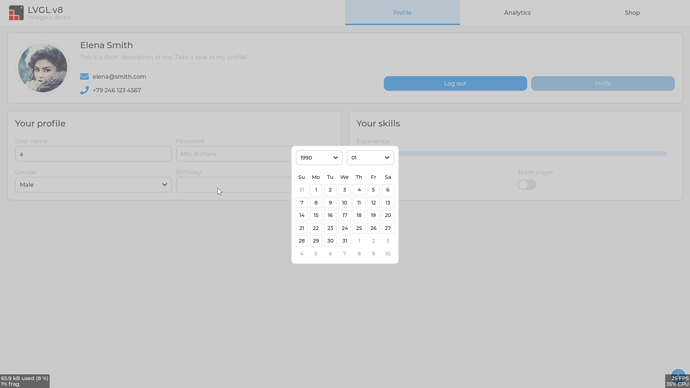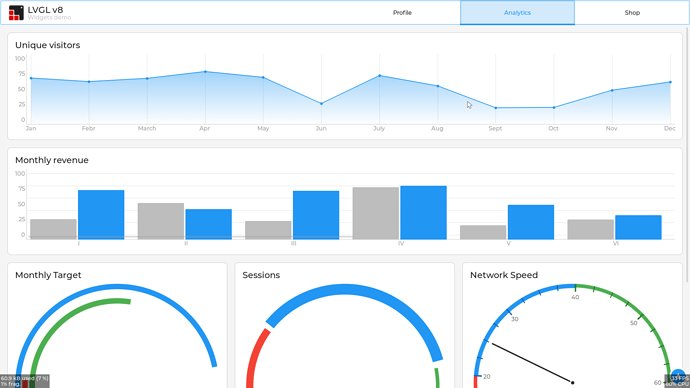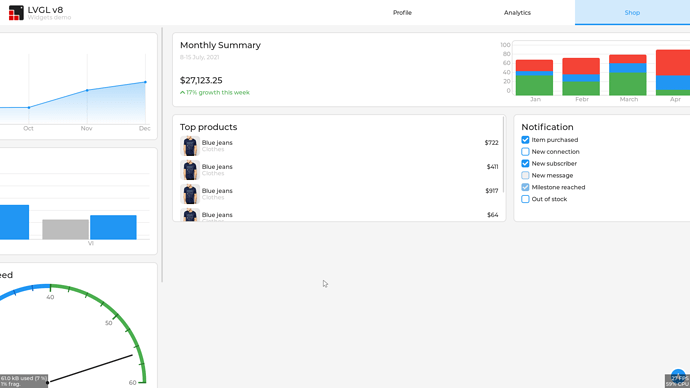Testing LVGL on Rock 5B.
Dependencies:
- SDL2 with HW accel (build and install my version or the latest sdl2 might work better)
- cmake up to date
Build demo, recipe:
mkdir -p lvgl
cd lvgl
git clone --recursive https://github.com/littlevgl/pc_simulator.git
cd pc_simulator
mkdir -p build
cd build
cmake ..
make -j8
Before you build you should enable, disable or change some settings:
diff --git a/lv_conf.h b/lv_conf.h
index 0b9a6dc..7cf0612 100644
--- a/lv_conf.h
+++ b/lv_conf.h
@@ -49,7 +49,7 @@
#define LV_MEM_CUSTOM 0
#if LV_MEM_CUSTOM == 0
/*Size of the memory available for `lv_mem_alloc()` in bytes (>= 2kB)*/
- #define LV_MEM_SIZE (128 * 1024U) /*[bytes]*/
+ #define LV_MEM_SIZE (896 * 1024U) /*[bytes]*/
/*Set an address for the memory pool instead of allocating it as a normal array. Can be in external SRAM too.*/
#define LV_MEM_ADR 0 /*0: unused*/
@@ -151,7 +151,7 @@
/*Maximum buffer size to allocate for rotation.
*Only used if software rotation is enabled in the display driver.*/
-#define LV_DISP_ROT_MAX_BUF (32*1024)
+#define LV_DISP_ROT_MAX_BUF (64*1024)
/*-------------
* GPU
@@ -184,7 +184,7 @@
#if LV_USE_GPU_SDL
#define LV_GPU_SDL_INCLUDE_PATH <SDL2/SDL.h>
/*Texture cache size, 8MB by default*/
- #define LV_GPU_SDL_LRU_SIZE (1024 * 1024 * 8)
+ #define LV_GPU_SDL_LRU_SIZE (1024 * 1024 * 64)
/*Custom blend mode for mask drawing, disable if you need to link with older SDL2 lib*/
#define LV_GPU_SDL_CUSTOM_BLEND_MODE (SDL_VERSION_ATLEAST(2, 0, 6))
#endif
diff --git a/lv_drivers b/lv_drivers
--- a/lv_drivers
+++ b/lv_drivers
@@ -1 +1 @@
-Subproject commit 1bd4368e71df5cafd68d1ad0a37ce0f92b8f6b88
+Subproject commit 1bd4368e71df5cafd68d1ad0a37ce0f92b8f6b88-dirty
diff --git a/lv_drv_conf.h b/lv_drv_conf.h
index 4f6a4e2..b40db57 100644
--- a/lv_drv_conf.h
+++ b/lv_drv_conf.h
@@ -95,8 +95,8 @@
#endif
#if USE_SDL || USE_SDL_GPU
-# define SDL_HOR_RES 480
-# define SDL_VER_RES 320
+# define SDL_HOR_RES 1920
+# define SDL_VER_RES 1080
/* Scale window by this factor (useful when simulating small screens) */
# define SDL_ZOOM 1
Tested with HDMI 1920x1080 and debug info. There is also a Wayland driver that may be a lot faster but as i don’t have Wayland i have not tested it.
Screenshots:





